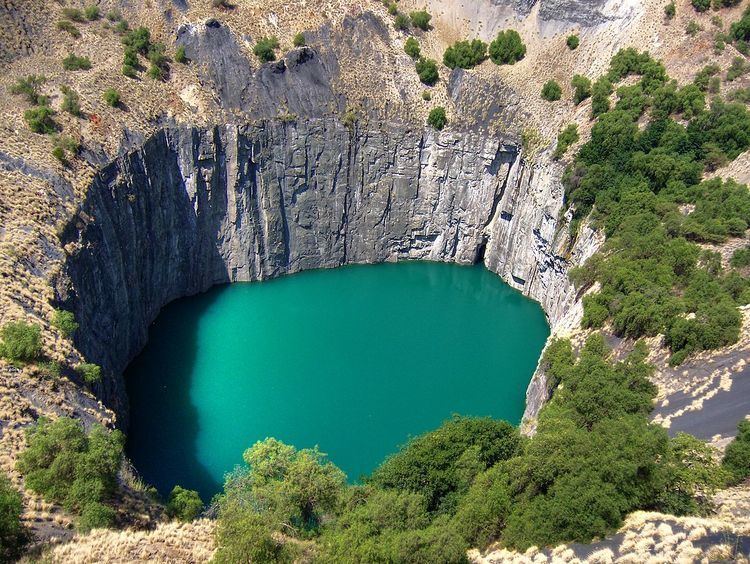Products Diamonds Province Northern Cape | Country South Africa Type Open-pit, underground Phone +27 53 839 4600 Opened 1871 | |
 | ||
Address S Circular Rd, Kimberley, 8300, South Africa Hours Closed now Wednesday9AM–4PMThursday9AM–4PMFriday9AM–4PMSaturday9AM–3PMSunday9AM–3PMMonday9AM–4PMTuesday9AM–4PM Similar Bingham Canyon Open Pit, Monticello Dam, McGregor Museum, Great Blue Hole, William Humphreys Art Gallery | ||
the end of the world mysterious big hole emerged in northern siberia
The Big Hole, Open Mine, Kimberley Mine or Tim Kuilmine (Afrikaans: Groot Gat) is an open-pit and underground mine in Kimberley, South Africa, and claimed to be the largest hole excavated by hand, although this claim is disputed.
Contents
- the end of the world mysterious big hole emerged in northern siberia
- History and size
- Excavation
- Mine Museum
- References
History and size
The first diamonds here were found on Colesberg Kopje by members of the "Red Cap Party" from Colesberg on the farm Vooruitzigt belonging to the De Beers brothers, in 1871. The ensuing scramble for claims led to the place being called New Rush, later renamed Kimberley. From mid-July 1871 to 1914 up to 50,000 miners dug the hole with picks and shovels, yielding 2,720 kilograms (6,000 lb; 13,600,000 carats) of diamonds. The Big Hole has a surface of 17 hectares (42 acres) and is 463 metres (1,519 ft) wide. It was excavated to a depth of 240 metres (790 ft), but then partially infilled with debris reducing its depth to about 215 metres (705 ft). Since then it has accumulated about 40 metres (130 ft) of water, leaving 175 metres (574 ft) of the hole visible. Once above-ground operations became too dangerous and unproductive, the kimberlite pipe of the Kimberley Mine was also mined underground by Cecil Rhodes' De Beers company to a depth of 1,097 metres (3,599 ft).
There is currently an effort in progress to register the Big Hole as a World Heritage Site.
Excavation
In 1872, one year after digging started, the population of the camp of diggers grew to around 50,000. As digging progressed, many men met their deaths in mining accidents. The unsanitary conditions, scarcity of water and fresh vegetables as well as the intense heat in the summer, also took their toll. On 13 March 1888 the leaders of the various mines decided to amalgamate the separate diggings into one big mine and one big company known as De Beers Consolidated Mines Limited, with life governors such as Cecil John Rhodes, Alfred Beit and Barney Barnato. This huge company further worked on the Big Hole until it came to the depth of 215 metres, with a surface area of about 17 hectares and perimeter of 1.6 kilometres. By 14 August 1914, when over 22 million tons of earth had been excavated, yielding 3,000 kilograms (14,504,566 carats) of diamonds, work on the mine ceased after it was considered the largest hand-dug excavation on earth. By 2005, however, it was reported that a researcher had re-examined mine records and found that the hand-dug portions of the Jagersfontein and Bultfontein diamond mines, also in South Africa, may have been deeper and/or larger in excavated volume. There are other, larger, mine excavations, but these were created using earth-moving equipment rather than manual labour.
Mine Museum
Mining operations having been closed down in 1914, the open pit became an attraction for visitors to the city and by the 1960s a gathering together of relics of Kimberley's early days, including old buildings and sundry memorabilia, began to be organised into a formal museum and tourist attraction. In 1965 De Beers appointed Basil Humphreys as museum consultant, with the museum being substantially upgraded as an open-air representation of early Kimberley, with streetscapes and dioramas, and exhibits of mining technology and transport. There was an official opening during the Kimberley's centenary celebrations in 1971. One of the attractions was the Diamond Hall. The Mine Museum went through subsequent further upgrades. Between 2002 and 2005 De Beers invested R50 million in developing the Big Hole into a world-class tourism facility, based on the idea of creating "a lasting legacy for the people of Kimberley." The new facility, the Big Hole Kimberley, elaborating a theme of 'Diamonds and Destiny', was expected to double visitor numbers to the Big Hole.
